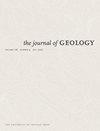沉积海相磷灰石中稀土元素混合成因的可能性——以埃及Abu-Tartur高原白垩系(Campanian-Maastrichtian) Duwi组磷灰岩为例
IF 1.3
4区 地球科学
Q2 GEOLOGY
引用次数: 3
摘要
众所周知,沉积磷灰石晶格中的稀土元素通常来源于环境海水。这项研究首次记录了埃及西部沙漠磷矿中存在的磷灰石稀土元素混合来源的可能性,称为Abu-Tartur磷矿,这是中东和北非最重要的沉积磷矿堆积之一。REEs的页岩状模式、负Ce异常和所研究的磷矿的(La/Sm)N−(La/Yb)N二元图表明,在晚期成岩过程中,环境海水通过置换作用将REEs结合到磷灰石晶格中。第二个成因归因于含REE的浅生流体,这导致沉积辉长岩以绿色边缘和斑块的形式出现,在黑色磷光体逐渐氧化为棕色的地方,总REE含量约为14.93wt%。例如,强烈的化学风化导致碳酸盐-氟磷灰石的晶格优先向溶液释放Ca2+和CO32-离子物种,从而形成碳酸盐贫化层,其中稀土元素,特别是重稀土元素,被掺入蚀变磷灰石晶格内的优先Ca2+位置,从而形成辉橄榄岩。本文章由计算机程序翻译,如有差异,请以英文原文为准。
Possibility of Mixed Origin of Rare Earth Elements in Sedimentary Marine Apatites: A Case Study from Phosphorites in the Cretaceous (Campanian-Maastrichtian) Duwi Formation, Abu-Tartur Plateau, Egypt
It is well known that the rare earth elements (REEs) incorporated in the crystal lattice of sedimentary apatite are commonly derived from ambient seawater. This study documents, for the first time, the possibility of mixed origin of apatite REEs present in the Egyptian Western Desert phosphorites, known as the Abu-Tartur phosphorites, one of the most important accumulations of sedimentary phosphorites in the Middle East and North Africa. Shale-like patterns of REEs, negative Ce anomalies, and a (La/Sm)N−(La/Yb)N binary diagram of the studied phosphorites indicate that the incorporation of REEs into apatite crystal lattices has occurred from the ambient seawater by substitution during late-stage diagenesis. The second origin is attributed to REE-bearing supergene fluids, which resulted in the occurrence of sedimentary britholite as green rims and patches containing about 14.93 wt% total REEs in places where the black phosphorites are gradually oxidized into the brown variety. For instance, the intensive chemical weathering induces the crystal lattice of carbonate fluorapatite to preferentially release Ca2+ and CO32− ion species to solution, resulting in the formation of a carbonate-depleted layer in which REEs, particularly heavy REEs, are incorporated into the preferential Ca2+ sites inside the altered apatite lattice, leading to britholite formation.
求助全文
通过发布文献求助,成功后即可免费获取论文全文。
去求助
来源期刊

Journal of Geology
地学-地质学
CiteScore
3.50
自引率
5.60%
发文量
0
审稿时长
3 months
期刊介绍:
One of the oldest journals in geology, The Journal of Geology has since 1893 promoted the systematic philosophical and fundamental study of geology.
The Journal publishes original research across a broad range of subfields in geology, including geophysics, geochemistry, sedimentology, geomorphology, petrology, plate tectonics, volcanology, structural geology, mineralogy, and planetary sciences. Many of its articles have wide appeal for geologists, present research of topical relevance, and offer new geological insights through the application of innovative approaches and methods.
 求助内容:
求助内容: 应助结果提醒方式:
应助结果提醒方式:


